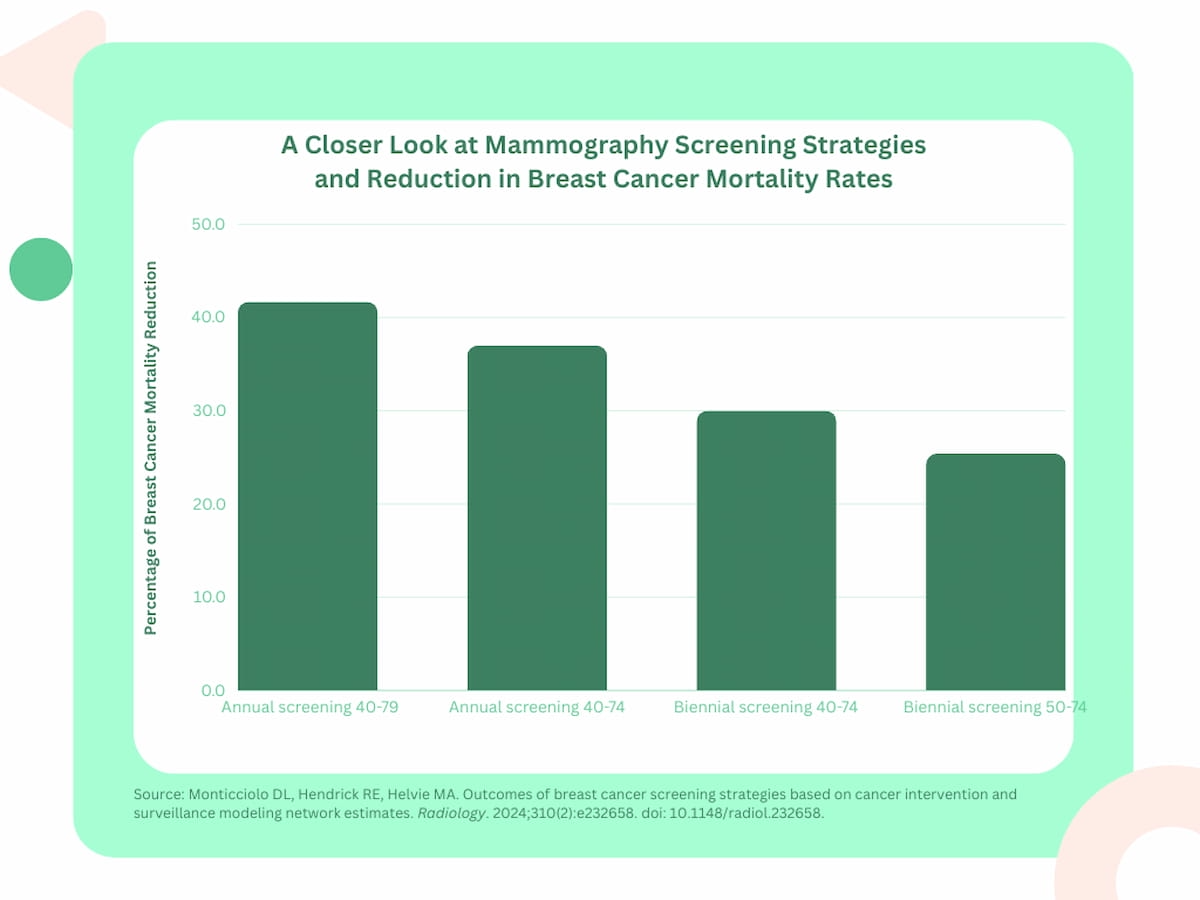Annual mammography screening between the ages of 40 and 79 offers the highest reduction of mortality from breast cancer in comparison to biennial mammography screening models and a shorter duration annual model that stops annual screening at age 74.
For the study, recently published in Radiology, researchers examined four different mammography screening frequencies based on published modeling estimates from the Cancer Intervention and Surveillance Modeling Network (CISNET). The assessed screening scenarios included: annual screening between the ages of 40 and 79; annual screening between the ages of 40 and 74; biennial screening between the ages of 50 and 74; and biennial screening between the ages of 40 and 74.
In an examination of digital breast tomosynthesis (DBT) estimates for 2023 (see “A Closer Look at Mammography Screening Strategies and Reduction in Breast Cancer Mortality Rates”), researchers found that annual screening between 40 to 79 years of age had the highest percentage of breast cancer mortality reduction (41.7 percent) in comparison to 37 percent for annual screening between the ages of 40-74, 30 percent for biennial screening between 40 and 74 years of age, and 25.4 percent for biennial screening between 50 to 74 years of age.
The researchers also found that annual mammography for women between the ages of 40 and 79 was estimated to gain 230 life-years per 1,000 screening exams, nearly double the estimate of life-years gained with biennial screening between 50 to 74 years of age (121 life-years).
“Our findings emphasize the limitations of restricting screening to women 50-74 years of age and of screening biennially rather than annually as previously described,” wrote lead study author Debra L. Monticciolo, M.D., a professor in the Department of Radiology at Dartmouth-Hitchcock Medical Center in Lebanon, N.H., and colleagues.
Annual mammography between 40 and 79 years of age had the lowest false positive rate at 6.5 percent, according to the study authors. In contrast, the researchers noted that biennial screening for women 50 to 74 years of age had a 7.8 percent false positive rate and biennial screening at 40-74 years of age was associated with an 8.3 percent false positive rate.
Three Key Takeaways
- Optimal age range for mammography screening. The study suggests that annual mammography screening between the ages of 40 and 79 provides the highest reduction in mortality from breast cancer compared to other screening models.
- Other benefits with annual screening. In addition to significantly higher breast cancer mortality reduction, annual mammography between the ages of 40 and 79 was associated with the lowest false positive rate (6.5%) and a substantial gain in life-years per 1,000 screening exams in comparison to other screening frequencies. The findings contradict recent U.S. Preventive Services Task Force (USPSTF) guidelines, which emphasize biennial screening, indicating a potential need for reconsideration of screening recommendations.
- Effectiveness of annual mammography screening in Black women. The study highlights that annual mammography screening between the ages of 40 and 79 is particularly beneficial for Black women with a higher number of averted breast cancer deaths and life-years gained compared to non-Black women.
Based on the 2023 DBT estimates for annual mammography between the ages of 40 and 79, the researchers also noted that Black women had a greater number of breast cancer deaths averted per 1,000 mammography screening exams in comparison to other women (15.5 vs. 11.5) and a significantly higher number of life-years gained per 1,000 screenings (309 vs. 230).
“Our review of CISNET estimates shows that beginning screening at 40 years of age and screening annually maximizes benefits for Black women. The number of breast cancer deaths averted and life-years gained are 42% higher for Black women than for non-Black women with annual screening ages 40–79 years with DBT,” noted Monticciolo and colleagues.
In an accompanying editorial, Bonnie N. Joe, M.D., Ph.D., expressed disappointment with the emphasis of the recent U.S. Preventive Services Task Force (USPSTF) guidelines on biennial mammography screening. Dr. Joe said the evidence from Monticciolo and colleagues demonstrates higher breast cancer mortality reduction and life years gained with annual mammography screening from 40 to 79 years of age. She also noted the study addresses concerns about over-screening.
“The probability of a false-positive screen per examination was less than 10% for all screening scenarios and lowest for annual screening at ages 40-79 years of age using 2023 CISNET DBT estimates,” emphasized Dr. Joe, the chief of breast imaging in the Department of Radiology and Biomedical Imaging at the University of California at San Francisco. “The risk of a benign biopsy per screening examination was less than 1.33% for all scenarios but lowest at 0.88% for annual screening at ages 40-79 years with DBT.”
(Editor’s note: For related content, see “Moving Beyond Mammography for Screening and Staging of Invasive Lobular Carcinoma,” “Study Examines Links Between Mammography Screening, Breast Cancer and Unmet Social Needs” and “What a New Mammography Study Reveals About BMI, Race, Ethnicity and Advanced Breast Cancer Risk.”)
In regard to study limitations, the authors noted the use of approximate estimates of the American College of Radiology (ACR), Society of Breast Imaging (SBI) and National Comprehensive Cancer Network (NCCN) recommendations for annual screening due to the CISNET model estimates only extending screening to the age of 74 in 2016 and the age of 79 in 2023. The researchers said they did not assess recommendations in respect to age-related variability with screening models.
